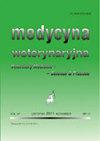Efficacy of an internal teat sealant alone or in combination with an intramammary antibiotic during the dry period treatment in dairy cows
IF 0.4
4区 农林科学
Q4 VETERINARY SCIENCES
Medycyna Weterynaryjna-Veterinary Medicine-Science and Practice
Pub Date : 2022-01-01
DOI:10.21521/mw.6735
引用次数: 0
Abstract
In this study, the aim was to determine the effectiveness of internal teat sealant applied at the dry-off in preventing the formation of subclinical mastitis and to investigate whether this product could be a non-antibiotic alternative to total dry cow treatment. A total of 195 quarters from 52 Holstein and Holstein Crossbreed dairy cows, that did not have clinical mammary infection and were expected to calve within 60 days were used in the study. The quarters were divided into 3 treatment groups as follows: Group 1 (ANTB; n = 64): dry period intramammary antibiotic suspension (Ubrostar®); Group 2 (ORB; n = 65), internal teat sealant (Orbeseal®); and Group 3 (ANTB-ORB; n = 66) intramammary antibiotic and teat sealant combination were performed. All of the quarters were checked for subclinical mastitis on the 20th, 40th and 60th days of lactation. The percentage of animals found to be CMT negative on the 20th day of lactation was 80.65% in G1 (ANTB), 83.60% in Group 2 (ORB), and 87.50% in Group 3 (ANTB-ORB), respectively. There was no quarter with CMT +3 score in G1 and G3, but it was determined in one quarter in G2 (ORB). On the 60th day there were no quarters with CMT +2 and +3 scores in both G1 and G2. No statistically significant difference was found between the CMT results of treatment groups on the 20th, 40th and 60th days of lactation (p > 0.05). In conclusion, it was determined that bismuth subnitrate-based teat canal sealer provided good protection against subclinical mastitis rate in drying healthy udder quarters. However, especially in high risk groups it is important to closely monitor udder health with SCC and/or CMT applications before the dry period and to choose the dry period treatment.乳内封闭剂单独使用或与乳内抗生素联合使用在奶牛干期治疗中的效果
在这项研究中,目的是确定在干燥时应用内乳密封剂在预防亚临床乳腺炎形成方面的有效性,并调查该产品是否可以作为全干牛治疗的非抗生素替代品。研究对象为52头荷斯坦奶牛和荷斯坦杂交奶牛,共195节,均无临床乳腺感染,预计在60天内产犊。各组随机分为3个治疗组:1组(ANTB);n = 64):干期乳内抗生素混悬液(Ubrostar®);第二组(ORB;n = 65),内耳密封胶(Orbeseal®);第3组(ANTB-ORB);66例患者行乳内抗生素联合乳内密封剂治疗。在哺乳期第20天、第40天、第60天检查亚临床乳腺炎。哺乳期第20天CMT阴性的动物比例,G1组(ANTB)为80.65%,2组(ORB)为83.60%,3组(ANTB-ORB)为87.50%。G1、G3无季度CMT +3评分,而G2 (ORB)有季度CMT +3评分。第60天,G1、G2均无CMT +2、+3的季度。各治疗组在泌乳第20、40、60天的CMT结果比较,差异均无统计学意义(p < 0.05)。总之,亚硝酸盐铋基乳管封闭剂对干燥健康乳房的亚临床乳腺炎有良好的保护作用。然而,特别是在高危人群中,在干期之前密切监测SCC和/或CMT应用的乳房健康状况并选择干期治疗是很重要的。
本文章由计算机程序翻译,如有差异,请以英文原文为准。
求助全文
约1分钟内获得全文
求助全文
来源期刊

Medycyna Weterynaryjna-Veterinary Medicine-Science and Practice
VETERINARY SCIENCES-
CiteScore
0.80
自引率
0.00%
发文量
73
审稿时长
4-8 weeks
期刊介绍:
"Medycyna Weterynaryjna" publishes various types of articles which are grouped in the following editorial categories: reviews, original studies, scientific and professional problems, the history of veterinary medicine, posthumous memoirs, as well as chronicles that briefly relate scientific advances and developments in the veterinary profession and medicine. The most important are the first two categories, which are published with short summaries in English. Moreover, from 2001 the editors of "Medycyna Weterynaryjna", bearing in mind market demands, has also started publishing entire works in English. Since 2008 the periodical has appeared in an electronic version. The following are available in this version: summaries of studies published from 1999 to 2005, full versions of all the studies published in the years 2006-2011 (in pdf files), and full versions of the English studies published in the current year (pdf). Only summaries of the remaining studies from the current year are available. In accordance with the principles accepted by the editors, the full versions of these texts will not be made available until next year.
All articles are evaluated twice by leading Polish scientists and professionals before they are considered for publication. For years now "Medycyna Weterynaryjna" has maintained a high standard thanks to this system. The review articles are actually succinct monographs dealing with specific scientific and professional problems that are based on the most recent findings. Original works have a particular value, since they present research carried out in Polish and international scientific centers.
 求助内容:
求助内容: 应助结果提醒方式:
应助结果提醒方式:


